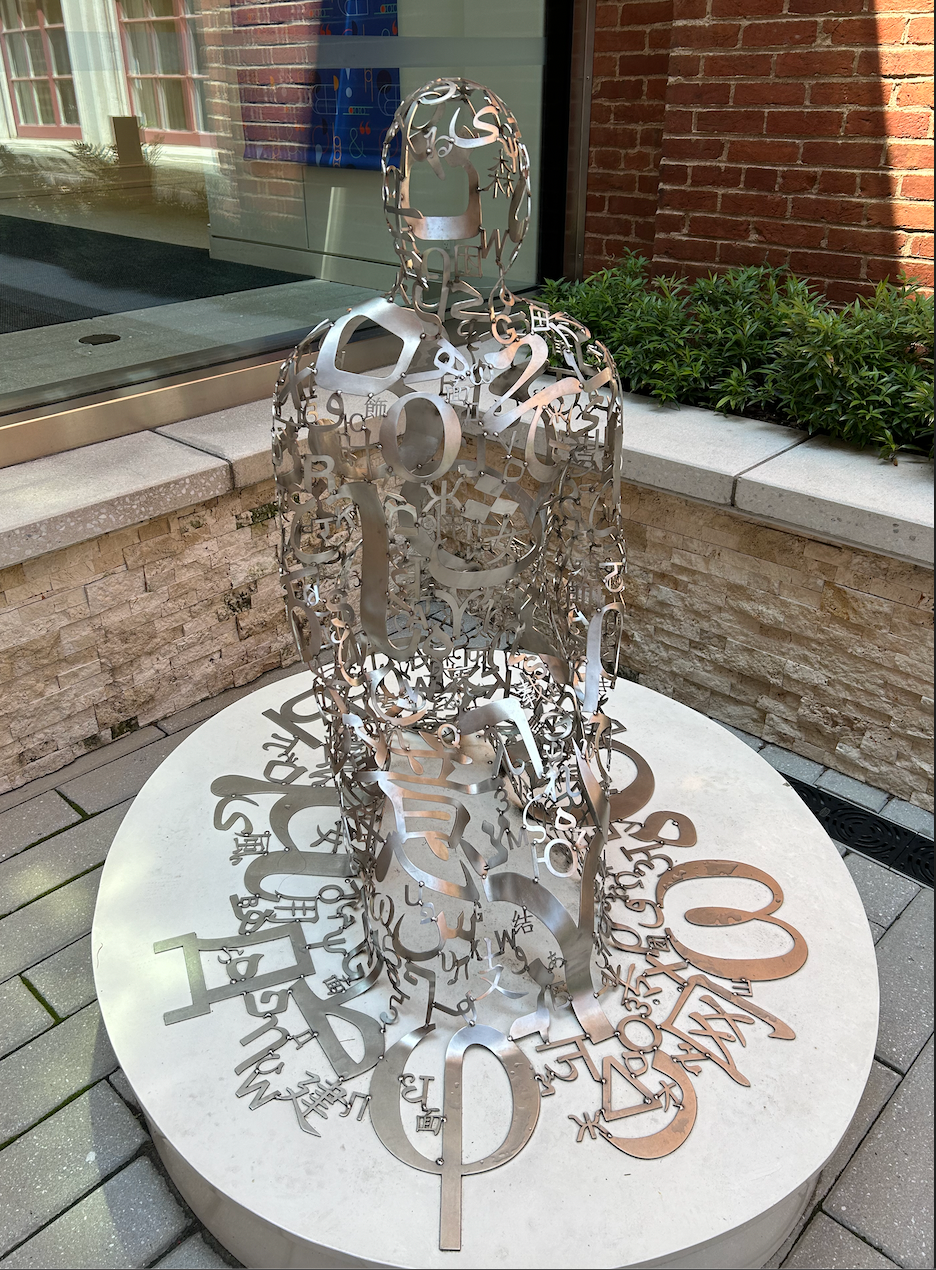Reflect with MIRA
- Anish Joseph

- May 31, 2024
- 13 min read
We speak, we write, we do language. That is how civilizations heal. Toni Morrison
Introduction to MIRA

MIRA aims to leverage natural and digital agents to create a platform for reflective storytelling, idea sharing, and orientation to resources, with a focus on user contributions and collaboration. MIRA explores how to integrate different aspects of being and knowledge into a cohesive platform. It is a concept that is being actively refined through collaboration with others based on the principles of a constructivist approach. The goal is to create an intelligent cognitive aid.
MIRA, an acronym for Modular Interactive Reflective Assistant, envisions a dynamic interface where users can engage in meaningful exchanges and contribute to a collective pool of knowledge. By blending the natural intelligence of humans with advanced digital tools, MIRA seeks to facilitate a deeper understanding and connection among its users.
The constructivist approach underpinning MIRA emphasizes active learning and participation, where knowledge is constructed through interaction and collaboration. This philosophy ensures that the platform evolves continuously, shaped by the insights and contributions of its diverse user base.
In essence, MIRA aspires to be more than just a tool; it aims to be a cognitive partner, aiding individuals in navigating the complexities of knowledge and personal growth. By fostering a community-oriented environment, MIRA encourages the sharing of ideas and experiences, making the pursuit of knowledge a shared journey.
Meanings of "Mira":
A Name: Often used as a female given name in various cultures.
Astronomy: Mira is a red giant star in the constellation Cetus, known for its variability in brightness.
Modular Interactive Reflective Assistant (MIRA): A hypothetical or fictional AI system.
Spanish Word: "Mira" means "look" or "watch" in Spanish.
Geography: Various places named Mira, such as Mira, Portugal, or Mira, Italy. Also, Altamira, known for the Altamira Cave in Spain, famous for its prehistoric cave paintings.
Biology: "Mira" could refer to a genus of insects or other organisms.
Meanings Across Different Cultures and Languages Relevant to

Seven Worldviews:
1. Judaism:
Hebrew: "Mira" can be a feminine given name meaning "bitter" (מרה), derived from the same root as "Miriam."
2. Christianity:
Latin/Spanish: "Mira" means "look" or "admire," often used as an imperative form of the verb "mirar" in Spanish. It symbolizes awareness and contemplation.
English: As a name, "Mira" can signify admiration or wonder, derived from the Latin "mirari," meaning to wonder or marvel.
3. Islam:
Arabic: "Mira" (مراء) can mean "two-faced" or "hypocrite," indicating insincerity and duplicity. It can also mean "mirror" (مرآة), reflecting a more positive meaning of reflection and self-awareness.
4. Hinduism:
Sanskrit/Hindi: "Mira" (मीरा) is associated with the 16th-century poet-saint Meera Bai, known for her intense devotion to Lord Krishna. Her name signifies devotion and spiritual love.
5. Buddhism:
Pali/Sanskrit: While "Mira" does not have a direct meaning in Pali or Sanskrit specific to Buddhism, it can be used as a personal name without specific religious connotations.
6. Sikhism:
Punjabi: Similar to Hindi, "Mira" can be associated with devotion. Although not a common name within Sikh traditions, it can symbolize devotion and piety.
7. Secular Perspective:
English: "Mira" can be used as a name meaning "admirable" or "wonderful," derived from the Latin "mirari." It also represents the name of a red giant star in the constellation Cetus, known for its variable brightness, symbolizing change and transformation in the universe.
Astronomy: "Mira" as a star signifies its prominent role in the night sky and its scientific importance due to its variability and red giant status.
Each of these meanings reflects the rich and diverse cultural, religious, and linguistic backgrounds in which the term "Mira" is used, providing a comprehensive understanding of its significance.
Etymology and Meaning: "Secular" vs. "Regular"

Secular:
Etymology: The term "secular" originates from the Latin word "saecularis," which means "worldly" or "pertaining to a generation or age." The Latin "saeculum" refers to a "century" or "age." The word entered the English language around the late 13th to early 14th century.
Meaning: "Secular" is used to describe things that are not connected to religious or spiritual matters. It pertains to worldly, non-religious affairs. For example, secular education focuses on subjects that are free from religious influence.
Regular:
Etymology: The term "regular" comes from the Latin word "regularis," meaning "consistent with rules." The root "regula" means "rule" or "standard." The word "regular" first appeared in English in the late 14th century.
Meaning: "Regular" generally refers to something conforming to a standard, consistent, or occurring at fixed intervals. It can describe patterns, habits, or practices that are systematic and orderly. In religious contexts, "regular" can refer to clergy who follow a specific religious rule or order, distinguishing them from secular clergy who are not bound by monastic rules.
Historical Usage:
Secular: The word "secular" has been used since the Middle Ages to distinguish between worldly and religious matters. It originally referred to clergy who were not part of a monastic order (i.e., not bound by monastic vows) and later extended to broader contexts distinguishing non-religious from religious activities.
Regular: "Regular" has been used in various contexts to denote adherence to rules or standards. In religious contexts, it distinguishes those following a monastic rule (regular clergy) from those serving in the secular world (secular clergy).
Comparison:
Secular: Focuses on non-religious, worldly aspects. Example: Secular education, secular government.
Regular: Focuses on adherence to standards or consistency. Example: Regular meetings, regular pattern. In religious contexts, it contrasts with "secular" to denote those following specific religious orders.
The words "secular" and "regular" have distinct etymological roots and meanings, with "secular" pertaining to non-religious, worldly matters and "regular" denoting adherence to standards or consistency, sometimes with religious connotations. Both terms highlight different aspects of societal and individual practices, emphasizing the diversity of language and its evolution over centuries.
The "Secular Way" and "Regular Way"

The Secular Way:
Definition: The "secular way" refers to practices, principles, and lifestyles that are not influenced by religious or spiritual considerations. It encompasses aspects of life and governance that operate independently of religious doctrines.
Contexts: Education, government, law, arts, and sciences are often described as secular when they are free from religious influence.
Examples:
Secular Education: Curriculum that focuses on subjects like science, mathematics, literature, and social studies without incorporating religious teachings.
Secular Government: A political system where laws and policies are made without reference to religious doctrines, often associated with the separation of church and state.
The Regular Way:
Definition: The "regular way" refers to methods, routines, or practices that adhere to established rules, standards, or norms. It implies consistency, orderliness, and adherence to a systematic approach.
Contexts: This term can apply to various areas including daily routines, business practices, and religious observances.
Examples:
Regular Practices: Routine actions such as brushing teeth twice a day or holding weekly meetings.
Religious Context: In religious contexts, "regular clergy" refers to those who live by a specific monastic rule, such as monks and nuns, as opposed to "secular clergy" who work in the wider community.
Intersections of Secular and Regular Ways:
Life:
Secular Life: Encompasses all aspects of existence that are independent of religious influence. This includes personal habits, social interactions, and professional activities that are governed by personal, societal, and legal norms rather than religious doctrines.
Regular Life: Involves routine and structured practices that bring order and predictability to daily living. This can include regular work schedules, exercise routines, and family rituals.
Intersection: A secular individual may still follow a regular life with structured routines that are essential for personal well-being and productivity.
Governance:
Secular Governance: Systems and policies that operate independently of religious doctrines. It includes the establishment of laws, regulations, and institutions based on rational and empirical principles.
Regular Governance: Involves the consistent application of laws and procedures. It emphasizes transparency, accountability, and regularity in the functioning of government bodies.
Intersection: Secular governments rely on regular practices such as regular elections, standardized procedures, and consistent application of laws to ensure fairness and stability.
Meaning:
Secular Meaning: Derives from personal, philosophical, and societal sources rather than religious texts or doctrines. Individuals find purpose through humanistic values, personal achievements, and societal contributions.
Regular Meaning: Found in the consistency and reliability of one’s actions and routines. Regular practices can provide a sense of stability and purpose, reinforcing one’s identity and role in society.
Intersection: Secular individuals may find meaning in regular, structured activities such as volunteering, professional achievements, or participation in community events.
Understanding:
Secular Understanding: Based on empirical evidence, scientific inquiry, and rational discourse. It emphasizes critical thinking, open inquiry, and the pursuit of knowledge through non-religious means.
Regular Understanding: Gained through systematic learning, habitual practice, and consistent application of knowledge. Regular study and practice in any field can lead to deeper understanding and mastery.
Intersection: Secular education often employs regular, structured methods to impart knowledge. Regular scientific research, for example, involves systematic experimentation and peer review to build a body of knowledge.
The "secular way" and the "regular way" are distinct yet intersecting concepts that play crucial roles in life, governance, meaning, and understanding. The secular way focuses on non-religious, worldly aspects, while the regular way emphasizes adherence to standards, rules, and routines. They intersect in their shared emphasis on order, consistency, and standardization, which are essential for the functioning of modern societies and institutions. By understanding these concepts and their intersections, we can appreciate how they shape various aspects of life, governance, personal meaning, and the pursuit of knowledge.
To encompass both the "secular way" and the "regular way," a word would ideally reflect aspects of worldly, non-religious matters (secular) and consistency, order, and adherence to standards (regular). To create such a word, we can draw from the Latin roots of both "secular" and "regular."

Suggested Word: Securegular
Breakdown of Roots:
Secular: Derived from the Latin word "saecularis," meaning "worldly" or "pertaining to a generation or age."
Root: "Secul-" (worldly, temporal)
Regular: Derived from the Latin word "regularis," meaning "consistent with rules."
Root: "Regul-" (rule, standard)
Constructing the Word:
Prefix: "Secu-" (from "secularis")
Root: "-regular" (from "regularis")
Meaning of "Securegular":
"Securegular" would signify practices, principles, and lifestyles that are worldly and temporal while also adhering to consistency, order, and standards. This word would encapsulate the essence of both secular and regular ways, emphasizing a balanced approach to life and governance that values both empirical, non-religious perspectives and systematic, rule-based consistency.
Usage Examples:
Securegular Governance: A system of governance that ensures laws and policies are both secular and applied consistently.
Securegular Lifestyle: A way of living that incorporates non-religious values and regular, structured routines.
Securegular Education: An educational approach that combines secular curriculum with regular, standardized methods of teaching and assessment.
"Securegular" is a constructed word that effectively combines the roots of "secular" and "regular," providing a comprehensive term to describe a balanced approach to life, governance, meaning, and understanding that integrates both worldly, non-religious perspectives and systematic, rule-based consistency.
Creating new words, also known as neologisms, is a common practice in language evolution. However, it can be seen as impractical in certain contexts for several reasons:
Lack of Understanding:
Confusion: Newly created words can be confusing if they are not immediately understood by others. This can lead to miscommunication, as the audience may not grasp the intended meaning without additional explanation.
Acceptance: New words often take time to be accepted and adopted into common usage. During this period, their utility is limited, as they may not be recognized or understood by a broader audience.
Existing Vocabulary:
Redundancy: There are often existing words that can effectively convey the intended meaning. Inventing new words might be unnecessary when the current vocabulary is sufficient to express the same ideas.
Clarity: Using established words ensures clarity and precision in communication. Existing words have well-defined meanings and connotations that are widely recognized.
Cultural and Contextual Relevance:
Cultural Context: Words are deeply rooted in cultural and historical contexts. New words might lack the cultural resonance and historical depth that established words possess.
Contextual Use: Words gain meaning through usage and context. New words do not have the same rich tapestry of contextual use and may seem artificial or forced.
Acceptance and Standardization:
Linguistic Acceptance: The process of a word becoming part of a language involves acceptance by linguistic authorities, like dictionaries and educational institutions. This can be a slow process, and not all new words achieve this status.
Standardization: Language benefits from a degree of standardization to ensure mutual understanding. Introducing too many new words can disrupt this balance and lead to fragmented communication.
Practical Implications:
Learning Curve: New words require people to learn and adapt to them. This learning curve can be a barrier, especially if the new words are complex or not intuitively understandable.
Integration: Integrating new words into educational materials, literature, and everyday use involves effort and resources. This can be seen as unnecessary when existing words suffice.
While creating new words can be a useful way to address gaps in language and express new concepts, it is often seen as impractical or "stupid" when it leads to confusion, redundancy, or lack of clarity. Effective communication relies on mutual understanding, and established vocabulary provides a shared foundation for this purpose. Therefore, it is generally more efficient to use and adapt existing words unless there is a clear and compelling need for a new term that cannot be met by the current lexicon.
Language is a living, evolving entity that changes over time to reflect new realities, ideas, and technologies. New words, or neologisms, traditionally come into existence through several mechanisms.

Mechanisms of Word Creation:
Back-formation:
Definition: Creating a new word by removing an affix from an existing word.
Example: "Edit" (from "editor"), "babysit" (from "babysitter").
Functional Shift:
Definition: Changing the word class of an existing word.
Example: "Google" (originally a noun, now also used as a verb, as in "to Google").
Coinage or Invention:
Definition: Creating entirely new words.
Example: "Kodak" (a brand name created by George Eastman), "Google" (originally a misspelling of "googol").
Affixation:
Definition: Adding prefixes or suffixes to existing words.
Example: "Unhappy" (adding the prefix "un-" to "happy"), "happiness" (adding the suffix "-ness" to "happy").
Acronyms and Initialisms:
Definition: Forming new words from the initials of a phrase.
Example: "NASA" (National Aeronautics and Space Administration), "scuba" (self-contained underwater breathing apparatus).
Blending:
Definition: Merging parts of two words to form a new one.
Example: "Brunch" (from "breakfast" and "lunch"), "motel" (from "motor" and "hotel").
Compounding:
Definition: Combining two or more existing words to create a new one.
Example: "Laptop" (from "lap" and "top"), "backpack" (from "back" and "pack").
Borrowing:
Definition: Taking words from other languages.
Example: The English language has borrowed extensively from Latin, French, and Germanic languages, among others. Words like "ballet" (French) and "piano" (Italian) are examples.

The Role of Teenage Girls in Language Innovation:
Historically, teenage girls have been identified as significant contributors to language change and the creation of new words. This phenomenon can be attributed to several factors:
Social Networks:
Influence: Teenage girls often have extensive social networks and engage in frequent communication. This high level of social interaction provides a fertile ground for linguistic innovation.
Example: The spread of slang terms and new expressions often starts within tight-knit social groups before permeating broader society.
Cultural Trends:
Trends: Teenage girls are often at the forefront of cultural trends, including fashion, music, and technology. Their language reflects these trends, leading to the creation of new words and phrases.
Example: Terms like "selfie," "hashtag," and "bae" gained popularity through social media and youth culture.
Creative Expression:
Creativity: Adolescence is a period of identity formation and self-expression. Teenage girls often experiment with language as a way to establish individuality and group identity.
Example: The use of creative spelling, abbreviations, and acronyms in texting and online communication.
Media and Technology:
Digital Influence: The rise of digital communication platforms like social media, texting, and instant messaging has amplified the voices of young people, allowing their linguistic innovations to spread rapidly.
Example: Words like "twerk," "ghosting," and "lit" have gained widespread usage through platforms like Twitter, Instagram, and TikTok.
New words come into existence through a variety of mechanisms, reflecting the dynamic and adaptive nature of language. Teenage girls, with their active social networks, engagement with cultural trends, and creative expression, play a pivotal role in driving linguistic innovation. Their influence is particularly pronounced in the digital age, where media and technology facilitate the rapid dissemination of new terms. Understanding the processes behind language evolution and the role of different demographic groups highlights the richness and complexity of human communication.

The Power of Language: Bridging and Dividing Societies
Language is a powerful tool that can both unite and divide people. Its influence extends beyond mere communication, affecting social dynamics, cultural identity, and human relationships. Here’s how language can both intentionally and unintentionally separate or bring people together.
Intentional Separation:
Exclusionary Practices:
Definition: Language can be used intentionally to exclude certain groups from participating in social, political, or economic activities.
Example: Legal jargon or technical language can create barriers for those not familiar with it, effectively excluding them from understanding or participating in legal or professional discourse.
Propaganda and Manipulation:
Definition: Language can be deliberately manipulated to promote divisive ideologies, spread misinformation, or incite hatred.
Example: Political propaganda can use language to create an "us versus them" mentality, fostering division and conflict.
Code-Switching and Dialects:
Definition: The deliberate use of specific dialects or sociolects can reinforce social boundaries and group identities.
Example: Elite social groups might use a particular accent or vocabulary to distinguish themselves from others, reinforcing social hierarchies.
Unintentional Separation:
Accents and Pronunciation:
Definition: Differences in accents and pronunciation can unintentionally create barriers.
Example: Non-native speakers might face discrimination or prejudice based on their accent, even if they are fluent in the language.
Cultural Differences:
Definition: Language reflects cultural nuances that might not be understood by outsiders, unintentionally creating barriers.
Example: Idiomatic expressions and cultural references can be lost in translation, leading to misunderstandings.
Language Evolution:
Definition: As language evolves, new slang or terminology can create generational divides.
Example: Older generations might find it challenging to understand the latest slang used by younger people, leading to a sense of disconnect.
Intentional Unification:
Storytelling and Literature:
Definition: Sharing stories and literature can create empathy and understanding across cultures.
Example: Books, films, and other media that tell diverse stories can bring people together by highlighting common human experiences.
Common Languages:
Definition: Establishing a common language can bridge diverse linguistic backgrounds.
Example: English is often used as a lingua franca in international business, facilitating communication between people from different countries.
Inclusive Language:
Definition: Deliberate efforts to use inclusive language can foster a sense of belonging and respect.
Example: Using gender-neutral terms and avoiding language that marginalizes groups can promote inclusivity.
Unintentional Unification:
Common Experiences:
Definition: Shared experiences, such as attending a concert or watching a sports event, can unite people despite language barriers.
Example: Non-verbal communication and shared enthusiasm in these settings can create a sense of community.
Cultural Exchange:
Definition: Cultural exchanges and interactions can naturally blend languages and foster unity.
Example: Migration and globalization have led to the blending of languages and cultures, creating more inclusive and diverse societies.
Language Learning:
Definition: Learning a new language can unintentionally lead to greater cultural appreciation and understanding.
Example: People who learn another language often gain insights into the associated culture, fostering empathy and connection.

Conclusion:
Language is a double-edged sword that holds the power to both divide and unite us. Its intentional use can either foster inclusivity and understanding or reinforce divisions and exclusion. Unintentionally, it can also create barriers or bring people together through shared experiences and cultural exchange. By being mindful of how we use language, we can harness its power to build bridges and foster unity.
As Toni Morrison wisely said, "We speak, we write, we do language. That is how civilizations heal." This quote underscores the profound impact of language in shaping our societies and healing divides, reminding us of the responsibility we hold in our words and communication.



Comments